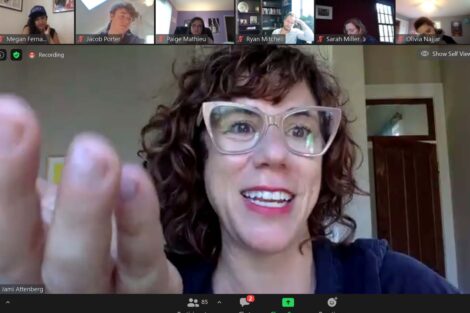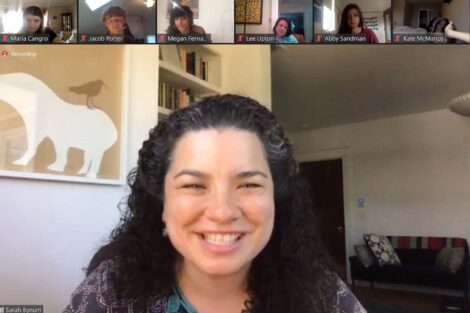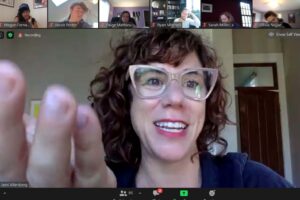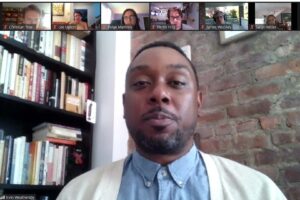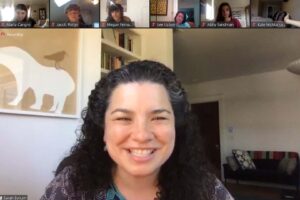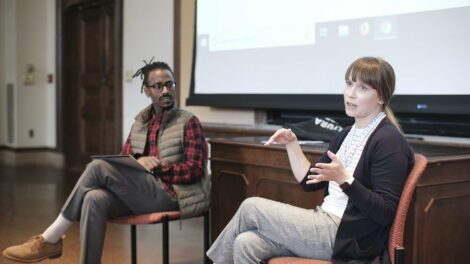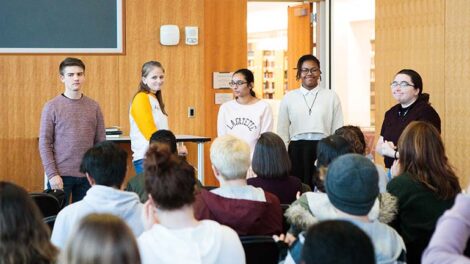Closs Residency adapts to serve students as virtual series, featuring readings and robust Q&A sessions
By Stephen Wilson
Imagine a dog cone, the kind used to limit a dog’s movement after surgery. Put that cone around your own neck, limiting your range of sight.
That’s how writer Sarah Shun-Lien Bynum describes the use of a third person narrator.
Irvin Weathersby recommended that students read How to Do Nothing.
And Jami Attenberg reminded young writers that things don’t always go in the order we want them to. “You start on a linear path but then mess it up in order to jolt the reader,” she says. “Writing, like life, is a series of land mines waiting to go off.”
Such ideas, advice, and recommendations only happen when you bring practitioners into a space and let them talk about their talents, lessons, and struggles.
This is what the Closs Residency provided in a year unlike any other.
The Ruth Mary Callahan Closs Residency was established in 1984 by Fred and Joan Closs in honor of Fred’s mother. Fred Closs was a long-time member of the Department of English.
A range of distinguished writers have visited classes, met with students, and given readings on campus through the Closs Residency, including Sherman Alexie, Peter Carey, Ping Chong, Maxine Clair, Christopher Durang, Danny Hoch, Marie Howe, David Lehman, Margot Livesey, Paula Morris, Idra Novey, George Saunders, James Tate, and S. L. Wisenberg.
But welcoming guests to campus was not possible during the pandemic.
So Jennifer Gilmore, assistant professor of English, Megan Fernandes, assistant professor of English, and Mikael Awake, assistant professor of English, talked about how to adapt the residency to still benefit the campus community.
“I feel fortunate that three of us talk often about our pedagogy, our curriculum, and how we can bring all kinds of voices into our classrooms,” says Gilmore. “An idea emerged out of a collective and organic conversation as we discussed how so many of our readings and creative writing events would be affected by the limitations of COVID.
“We decided to take the fund and in its spirit, enhance the remote environment for students. Because travel was prohibitive globally, we were able to reduce costs significantly and ask writers only for an hour of their time, and so a nine-person series emerged.”
Nine writers over the course of the fall semester held virtual visits that balanced between a reading of their work and robust Q&A session.
Writers included Sarah Shun-lien Bynum, Irvin Weathersby, Ariel Francisco Henriquez Cos, Emily Raboteau, Jordy Rosenberg, Hafizah Geter, Jami Attenberg, Jenna Bond, and Taylor Johnson.
“This series was a reflection of our experiences as writers and readers,” says Awake. “Our shortlists were bespoke to our lives: friends made through being a writer and going to literary events, former classmates or colleagues who’ve kept writing, and, of course, the people we’ve long admired from afar.
“As the resident nonfiction specialist, I made it a point to invite writers who are exploring how it feels to be alive right now and also have an expansive and compelling view of how we got here. Who is making beautiful work out of struggle? Who is suggesting new worlds and ways of seeing?”
Since writers across the country were navigating the same shelter-in-place approach to life, their invitations were met with overwhelmingly affirmative responses.
Each guest session provided different insights that student writers could leverage in their own work and the workshopping of their peers.
“One of the ideas I think we wanted students to hold close this semester was about the relationship between creativity and community,” says Awake.
“This pandemic-specific format was a way to be together in a semi-regular fashion, to establish a routine during a time that felt so bleak and out of control, and to engage in conversations,” says Fernandes.
How did it impact students?
“I think our students are hungry for writers who are grappling with the now, which of course means reckoning fully with what brought us to the now,” says Awake. “The diversity of our series showed them that literary art has many uses, many entry points, and that there is no linear or singular path to arriving at a literary artistic practice.”
“It was moving to see the way those discussions made their way back into our classroom, well, Zoom room,” Gilmore says. “How do these writers make the decisions they make on the page? Why? We talked about it all semester. It was an invaluable resource to all of us.”
“Though not technically a young writer anymore, I’ll add that I too learned so much from this Zoom series and the generosity of these writers and the profound ways our students engaged with their work during this incredibly hard and painfully prolonged time,” says Awake.
